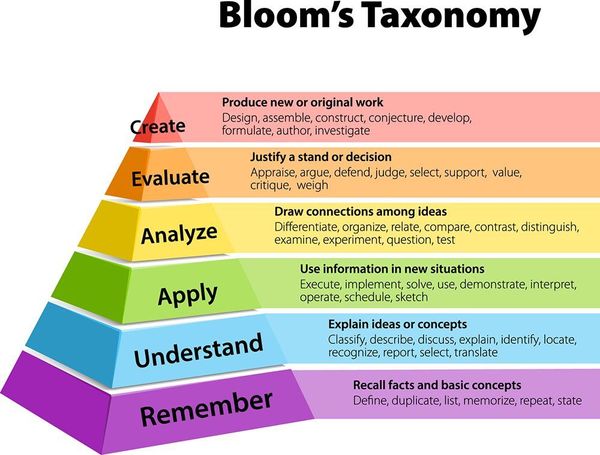Bloom's Taxonomy for Learning

We will learn how to learn better using Bloom's Taxonomy
Oct 16, 2024
Introduction
Bloom's taxonomy of knowledge and skills is very interesting because you can use it a lot when you are learning new concepts. Bloom’s revised taxonomy consists of 6 levels of learning, where the higher the level of your learning the better. Here I will explain various levels of the taxonomy along with examples and how to learn at that level. I will use trigonometry for the examples.
Level 1 - Remember
Level 1 is all about memorizing concepts. At this level you are able to recall specific concept definitions. For example, knowing that the sin of an angle is the opposite side to that angle divided by the hypotenuse is level 1 knowledge. Learning at this level involves re-reading, and recalling many times. Being at level 1 gives you the ability to regurgitate.
Level 2 - Understand
Level 2 is all about understanding concepts. At this level you are able to explain and answer questions that other people ask. For example, knowing that sin of any angle is the same no matter what the opposite and hypotenuse sides are because of similar triangles is level 2 knowledge. Learning at this level involves reading slowly and trying to wrap your head around a concept. Being at level 2 gives you the ability to explain and answer questions thoroughly.
Level 3 - Apply
Level 3 is all about applying the concept. At this level you are able to solve simple problems which need direct application of the concept. For example, using the fact that sin of an angle to find the opposite side given the hypotenuse is level 3 knowledge. Learning at this level involves solving direct formula application problems. Being at level 3 gives you the ability of simple problem solving.
Level 4 - Analyze
Level 4 is all about analyzing concepts and their relation to other concepts. At this level, you have to compare and contrast concepts with other concepts as well as break the concept into smaller parts and understand how they are integrated. For example, comparing trigonometry to geometry and finding the similarities and differences with similar triangles is level 4 knowledge. Creating venn diagrams, tables, summaries, mind maps, and solving complex problems can all be used in level 4. Being at level 4 gives you the ability to compare multiple concepts and solve more complicated problems.
Level 5 - Evaluate
Level 5 is all about judging and evaluating information. At this level you are able to understand the limits of concepts and when and why they work and dont work. For example, asking, “why is trigonometry important?”, and limitations like, “is trigonometry applicable to Earth’s surface which is curved?” is level 5 knowledge. To learn at this level, you have to ask questions like “Why does it matter?” “When does it not work?”. Mind maps, teaching, answering questions, and creating summaries can all be used in level 5. This can give you the ability to prioritize specific information over other information.
Level 6 - Create
Level 6 is all about creativity and creating your own information. You have to identify gaps that you can fill up in your topic. For example, from knowing what similar triangles are, to creating sin, cosine, and tangent functions independently is level 6 knowledge. Level 6 is a lot more fluid because it is creating new concepts. One thing that can help is keen observation and asking lots of why questions, like level 5. This can give you the ability to hypothesize and reason about new ideas that didn’t exist before.
Lessons for learning
Levels 1 and 2 help us understand the “what” of the concept, level 3 and 4 help us understand the “how” of the concept, and level 5 helps us understand the “why” of the concept.
Most students learn at level 1-3. The jump from level 3 to level 4 can make you feel like you’re going slower than what you were in level 3. This is because it requires more mental effort to look through everything and analyze, but this also makes it easier to remember, as concepts are understood as interconnected and makes learning stronger. Also, instead of starting to learn from level 1 to level 5, you can also start at level 5 and go down to learning to level 1. Going from level 5 to level 1 is usually better since your brain automatically fills in levels 1-3 when you learn at level 4 and 5. This does not apply the other way around.
Conclusion
Thinking about this can help with learning concepts better, especially if you deliberately try to stick to a specific level of learning. I’m trying to target level 4 or level 5 for learning, which might also be a good goal for you!